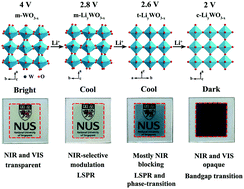Monoclinic oxygen-deficient tungsten oxide nanowires for dynamic and independent control of near-infrared and visible light transmittance†
Abstract
The transmittance of near-infrared (NIR) and visible (VIS) light spectral regions can be dynamically and independently controlled using a single-component material – monoclinic oxygen-deficient tungsten oxide nanowires, without the need for compositing with other electrochromic materials. A localized surface plasmon resonance and phase-transition assisted mechanism and bandgap transition electrochromism are individually responsible for the modulation of the NIR and VIS light transmissions.



 Please wait while we load your content...
Please wait while we load your content...